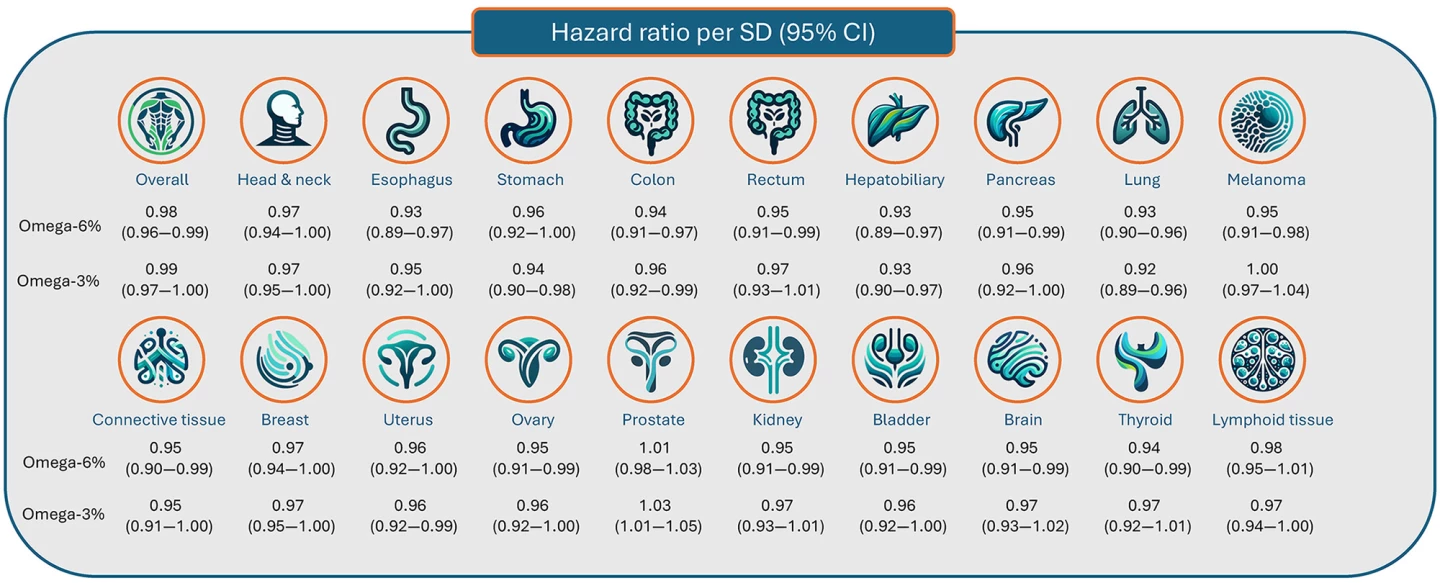New research has linked higher plasma levels of the healthy fats omega-3 and omega-6 to a reduced risk of developing particular types of cancer. The study adds to the on-again/off-again relationship that exists between scientists and the common supplements.
Omega-3 and omega-6 fatty acids, usually found in fish supplements, have enjoyed their time in both the (scientific) sun and the cold, cold shade. On the one hand, studies have found that fish supplements reduce the risk of childhood asthma and have cardiovascular benefits. However, studies have also found that they don’t reduce heart disease or cancer risk and don’t prevent depression.
A new study led by the University of Georgia (UGA) in the US falls squarely in the ‘pro’ pile (at least for now). Researchers have found that omega-3 and omega-6 fatty acids reduce the risk of developing a pretty large number of site-specific cancers.
“Higher omega-3 and omega-6 levels were associated with lower rates of cancer,” said Yuchen Zhang, a doctoral student in UGA’s College of Public Health and the study’s lead author. “These findings suggest that the average person should focus on getting more of these fatty acids in their diets.”
Omega-3 and omega-6 are polyunsaturated fatty acids (PUFAs); put simply, they’re ‘healthy fats.’ There are three physiologically relevant omega-3s: alpha-linolenic acid (ALA), found in plants, and eicosapentaenoic acid (EPA) and docosahexaenoic acid (DHA), found in fish and algae. Omega-6 fatty acids are found in vegetable oils, nuts and seeds.
The researchers investigated the association between plasma levels of omega-3 and omega-6 PUFAs and the incidence of overall and 19 site-specific cancers using data on 258,138 participants obtained from the UK Biobank. The cancer sites were head and neck, esophagus, stomach, colon, rectum, hepatobiliary tract (liver and gallbladder), pancreas, lung, malignant melanoma, connective soft tissue, breast, uterus, ovary, prostate, kidney, bladder, brain, thyroid, and lymphoid and hematopoietic tissue (which produce blood cells).
The average age of study participants was 56.4, and 90.9% of them identified as white. Over an average follow-up time of almost 13 years, 29,838 participants were diagnosed with cancer. The researchers found that participants with higher plasma levels of omega-3s had lower rates of five of the 19 site-specific cancers, including colon, stomach and lung cancer. Participants with higher omega-6 levels had lower rates of 14 of them, including brain and bladder cancer and malignant melanoma. It wasn’t the case with prostate cancer, however, where a high omega-3 level was associated with a slightly higher risk of that type of cancer.

To convert the hazard ratio (HR) of any of the cancer types in the above image into a percentage of risk reduction, you can use the following formula: Risk reduction (%) = (1 – HR) 100. For example, the HR for head and neck cancer is 0.97. So, (1 – 0.97 = 0.03) 100 = a risk reduction of 3%.
Although there are no official guidelines, most organizations recommend that healthy adults have a minimum of 250 to 500 mg of combined EPA and DHA each day. You can get that from about 227 g (8 oz) of fatty fish a week. Nuts and seeds contain significant amounts of omega-6. According to the Food and Nutrition Board of the US Institute of Medicine, the adequate daily intake of omega-6 is 17 grams (0.6 oz) for males and 12 grams (0.4 oz) for females aged 19 to 50.
“For women, it’s an easy decision: eat more omega-3,” said Kaixiong Ye, associate professor in UGA’s Franklin College of Arts and Sciences and the corresponding author on the study.
There are obvious limitations to the study, notably that the participant sample was heavily skewed toward European ancestry and white ethnicity. This means that results may not be generalizable to diverse ancestral backgrounds and ethnicities. Additionally, the number of events was small for some specific cancer sites, which may reduce the study’s statistical power. Because individual genetics weren’t taken into account, future research should also investigate whether specific genetic variants modify the association between cancer and PUFAs.
Regardless, the researchers say the study “laid a solid foundation for future mechanistic studies into the roles of PUFAs in the etiology of various cancers. It also provided insights into the development of cancer prevention strategies by managing circulating PUFAs.”
The study was published in the International Journal of Cancer.
Source: UGA






